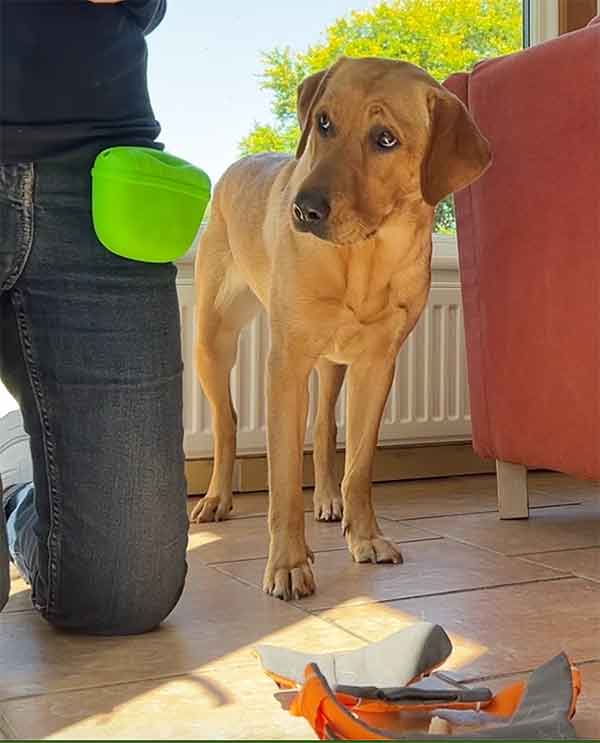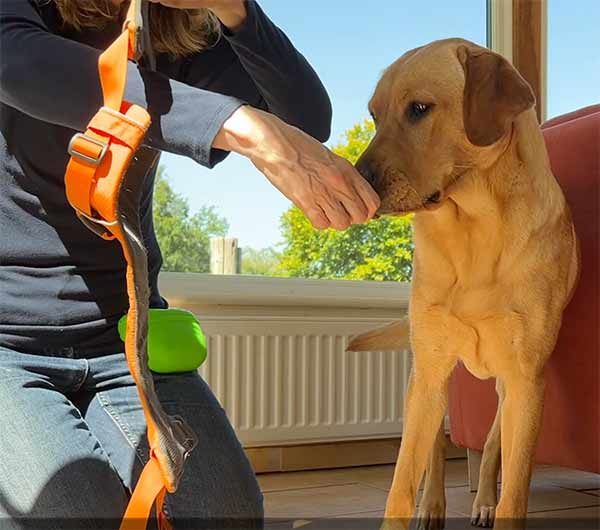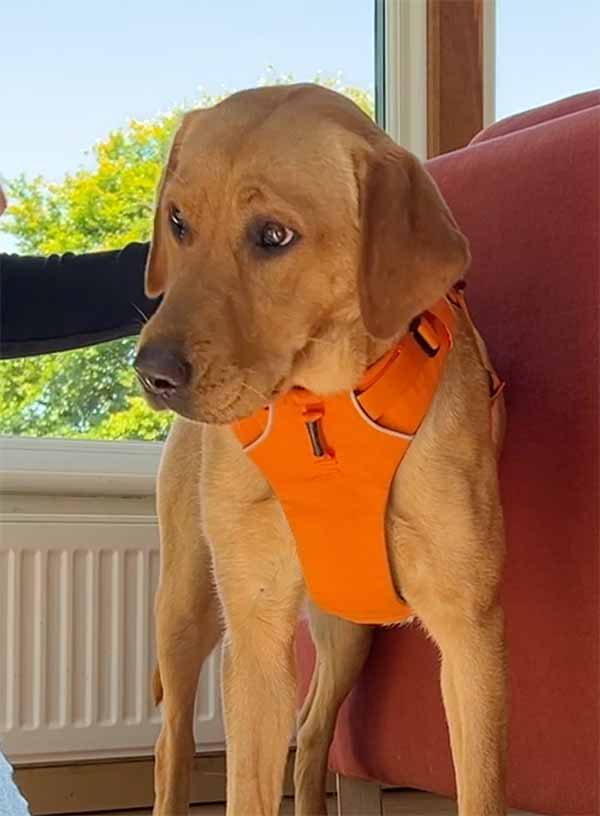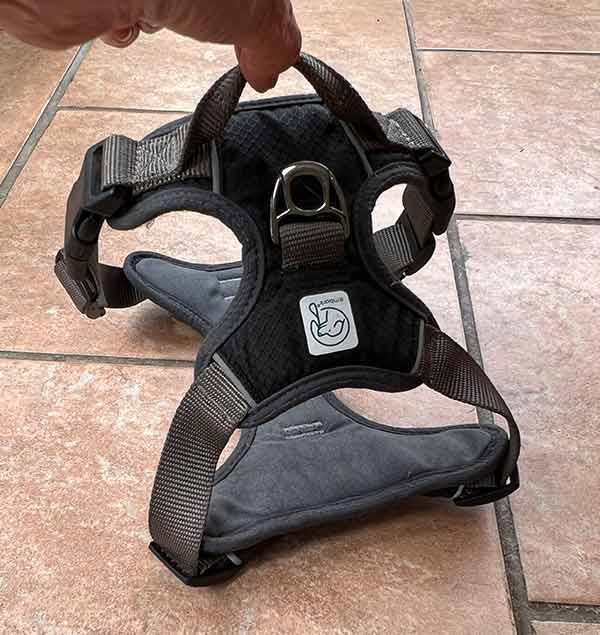How To Get Your Dog Into A Harness Without A Fight: Mini-Course And Video
Modern dog trainers are increasingly recommending harnesses over dog collars for puppies and adult dogs alike.
I recommend a body harness for most of my students’ dogs. And I’m going to show you how to get your dog into and out of their harness, using a few simple games. I’ll also give you some tips on buying a harness below.
Is it worth the bother of teaching a dog to wear a harness?
It will probably take you a few days to get your Labrador comfortable with the harness using this method, and I think it’s well worth the effort.
The most important reason for using a harness on your dog is to protect their throat. I’m sure you’ve seen dogs gagging and choking as they drag their owners down the street.
You’d think that the dog would just stop pulling if they were harming themselves, but they don’t. And I’ve had a fresh reminder of that with Reggie the little rescue terrier I’m looking after at the moment! He will pull until he makes himself cough horribly.
In fact, some dogs will pull so hard into a collar that they do permanent damage to the soft tissues of their throat. So Reggie’s new family will be harness training him soon!
Why not just teach your dog to walk nicely on a leash?
Of course, the ultimate aim should be to teach your dog to walk next to you. This can take a little while, and in the meantime a harness is a safer option for a dog that pulls, than a collar. It’s also a great tool for puppy parents.
With small puppies, when you are out and about working on socialization, the harness will protect your puppy’s throat if they attempt to dash off impulsively as puppies are inclined to do.
The training strategy
It’s one thing knowing that a harness is beneficial to your dog, but it’s quite another getting your dog into one. The fact is, many dogs don’t like harnesses at first. It feels strange and new.
The good news is, this is usually a straightforward problem to fix. Our strategy is simple. We do it by using your Labrador’s fondness for food. You’ll be teaching them to accept food that is offered through the harness, and then to put their head through the harness in order to reach the food.
This method works for dogs of any age, with most kinds of overhead type harness, where you put a neck loop over the dog’s head. (Not the kind of harness that the dog steps into).
My youngest Lab Bonnie is demonstrating the steps. And she is wearing the Ruffwear Front Range harness(paid link) which comes in a range of different colors. Bonnie’s harness color is ‘campfire orange’, and her harness size is ‘Medium’.
I do not get compensation from Ruffwear and the opinions you’ll find here are entirely my own. There are, however, some amazon links in this article and we earn a small commission from Amazon (at no extra cost to you) if you make a purchase through them
Fitting The Harness: Training steps & routine
The first step is to show the dog that not only is the harness harmless, but that it’s also associated with food. We’ll make the whole process into a series of games.
Play each game several times a day for a couple of days.
Then, provided the dog is able to complete the game, you can move onto the next one.
For these games you’ll need some extra special treats. You need to pick something that your dog really loves. Cold roast meat tends to go down well.
For Bonnie I’m using some left over roast chicken, and cold sausages cut up into small pieces. If your dog tolerates dairy food then tiny pieces of cheese can work well too.
Make sure that the belly straps on the harness are unclipped before you begin.
Game 1: Lay the harness on the floor
Step 1:
Throw a treat away from you. While your dog is collecting it, lay the harness on the floor and scatter treats around it for the dog to eat.

If the dog is anxious about approaching the harness, start by treating further from it, and each time you play the game put the treats closer to the harness. When the dog will eat treats place within an inch or two of the harness, move on to step 2
Step 2:
Place four or five treats in the neck loop for the dog to eat.
Game 2: Your arm through the neck loop
The next stage is to lift the neck loop off the floor, put your hand through it, and feed from your hand.
Step 1:
Holding the neck loop in one hand letting the belly straps of the harness rest on the floor. Take one treat in your other hand and push it through the loop towards your dog’s mouth.

The neck loop of the harness should be half-way up your forearm when the treat reaches your dog’s mouth. Withdraw your arm and take another treat. Feed in exactly the same way. Repeat with five to ten more treats
Step 2:
Now you will repeat step one but this time you won’t push your arm so far through that neck loop. Try putting just your hand through, so that the loop is around your wrist.
Feed one treat, remove your hand to get another treat, and repeat. Do another five of these.
Game 3: Your dog’s nose through the neck loop
In this game you’ll withdraw your hand in gradual stages so that by the end of the game the dog is putting their head through the loop to get the treat.
Step 1:
Holding the neck loop in one hand with the belly straps of the harness resting on the floor. Take one treat between the thumb and first two fingers of your other hand and push those fingers and no more, through the loop towards your dog’s mouth.
When your dog has taken five treats, one at a time from in front of the loop with just your fingers poking through it, move on to Step 2.
Step 2:
Repeat Step 1 but this time hold your fingers so that the treat is in the center of the loop. Not in front or behind, but right in the middle.
Step 3:
In this Step, you’ll hold your fingers just behind the loop so that the dog has to put their nose through the loop in order to take the food.
Game 4: Fitting And Removing The Neck Loop
The neck loop or collar part of the harness going over the dog’s head is a sensation that some dogs dislike at first. In fact taking it off can be worse for the dog than putting it on. That’s because if it’s done wrong, it tugs on the dog’s ears.
I’ll explain how to prevent that. And in this game you’ll practice taking the neck loop on and off the dog until they are relaxed about it.
Before you start, adjust the neck loop so it’s loose. We’ll tighten it up once the dog is used to the feel of it.
Step 1:
Hold the neck loop in one hand with the belly straps of the harness resting on the floor. Take one treat between the thumb and first two fingers of your other hand and offer the treat from just behind the loop.
As the dog puts their nose into the loop, move your hand back a little so that their head goes part way through but do not let the loop go over the dog’s ears. Aim to get their eyes through then feed and move the loop back. Pick up another treat and repeat several times. Then move onto step 2
Step 2:
This is where we put the neck loop over the dog’s head. Hold the neck loop in one hand with the belly straps of the harness resting on the floor. Take one treat between the thumb and first two fingers of your other hand and offer the treat from just behind the loop.
As the dog pushes their face through the loop gently slide it up and back so that it slips over your dog’s head and rests on their neck. Now feed several treats in a row.
Step 3:
This is where we remove the neck loop. Before you do so, you’ll turn the fabric of the neck loop or collar part of the harness, so that the cone shaped entrance faces the other way and doesn’t catch on your dog’s ears as you slide it off. You’ll probably need to watch the video to understand what I mean.
Have some treats ready in your hand, and once you have turned the collar inside out feed the dog while you slide it over the dog’s head and up your arm.
You’ll need to practice putting the neck loop/ collar of the harness on and off the dog ten to twenty times before you move onto the final game. Only move on if the dog is happy and relaxed about having the neck loop pulled on and off their head
Game 5 Final touches
In this game you’ll fit the harness on your dog. And give the harness the feel good factor.
Step 1
Hold the neck loop in one hand with the belly straps of the harness resting on the floor. Take one treat between the thumb and first two fingers of your other hand and offer the treat from just behind the loop.
As the dog pushes their face through the loop gently slide it up and back so that it slips over your dog’s head and rests on their neck. Now feed several treats in a row.
Step 2
Slide your hand behind the dog’s front leg, take hold of the chest piece and attach the belly clip nearest to you. Feed several treats in a row. Put your hand over the dog and attach the second belly clip. Feed several treats in a row.
Step 3
Unclip both belly straps. Feed several treats in a row. Turn the neck collar inside out. Have some treats ready in your hand, and feed the dog while you slide the neck loop over the dog’s head and up your arm. Feed more treats as you move the harness away from the dog.
Step 4
Now practice putting the harness on and leaving it on temporarily during activities that your dog really enjoys. Put the harness on before your dog’s meals and take it off afterwards. Your dog likes playing tug? Put the harness on first. Expecting a visitor that your dog loves? Harness on first. Keep this up for a week or two, putting the harness on before fun activities, and removing it afterwards.
The harness should now be firmly associated with pleasure! Here are a few tips to help you get the most from these games.
Game Play Tips
Don’t move the goalposts when your dog is already full of treats or has just eaten a meal. When you are asking for more challenging responses for the dog, they should be hungry and eager to play!
There are five games. I recommend you spend one to five days on each one. One day per game for a dog that has no previous experience of a harness. And at least three days per game for a dog that dislikes having a harness put on.
Don’t try to pack several games into a single day. You’ll find you can make fast progress initially, but when it comes to the harness actually touching the dog’s head, they may balk and pull back. And then you’ll find it takes longer to build up to that point again.
Choosing A Harness
When you are choosing a harness for your dog, its important that you pick one that doesn’t interfere with your dog’s leg action. So no chest straps the run across the front of the dog’s shoulders.
There are only two harnesses that I use and recommend. They are the Ruffwear Front Range Harness(paid link), and the Embark Adventure Dog Harness(paid link)
 (paid link)
(paid link)The Ruffwear Front Range harness is a really sturdy piece of kit. It has front and back attachments which is important and comes in a huge range of colors. I have been using these for a decade now, and I have several different sizes. I throw them in the washing machine occasionally, and I have never had to mend or replace any part of any of my Ruffwear harnesses.
 (paid link)
(paid link)The Embark Adventure harness is a close second to the Ruffwear. It’s put together in the same way, and it is usually a little less expensive. It also has a hand grip on the back which is quite useful for some of the games we play with our dogs. I only have one of these, not because there is anything wrong with it, it’s just that the Ruffwear is my favorite. My Embark harness belongs to my Cocker Spaniel, I’ve photographed it without her because she’s black and you can’t see much of it when she’s wearing it!
A couple of extra thoughts
A lot of body harnesses have ‘no pull’ written into the description and I think that this can be misleading. A standard body harness cannot completely prevent your dog from pulling, only training can do that. Though a front attachment harness may help you manage this habit while you train your dog.
You’ll also find some traditional trainers claiming that harnesses encourage dogs to pull. This is also untrue. I think it’s probably a myth that’s arisen because some activities that involve pulling, sled dog sports and tracking for example, are usually carried out with the dog in a harness.
It’s also worth pointing out that harnesses are not completely escape proof. I have known dogs that were adept at backing out of all kinds of harness, usually because they were too loose. So make sure that your dog’s harness is snugly adjusted with not too much wiggle room!
Keeping it fun
Wearing a harness should be fun for your dog. Wherever you are at with your harness training, if it isn’t fun for the dog then its time to go back to an earlier stage in training with some awesome treats, and make wearing a harness a pleasure again.
I hope you enjoyed this mini-course. If you’d like to play more training games with your dog, visit the Dogsnet website, and to be the first to watch my new videos, please subscribe to the Dogsnet Youtube channel. You can get help and support for all my Dogsnet videos on the Dogsnet Training Facebook Group, and if there are other topics you’d like help with feel free to make suggestons for videos in the comments below!

Free Labrador Updates!
Get my training tips, news, reviews, and the latest from The Labrador Site delivered to your inbox


The video is giving the dog too many treats my dog is overweight and all these treats are not going to help.
Hi Millie, The treats we give during training are deducted from our dog’s daily ration of food, so no need for extra calories, they are just spread out in a different way. Best wishes, Lucy